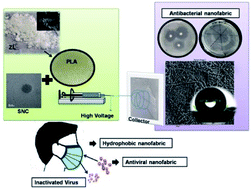Functionalized poly(lactic acid) based nano-fabric for anti-viral applications†
Abstract
This study endeavoured to explore and fabricate antiviral and antibacterial facemasks using zinc (oligo-lactate) (ZL), developed through a microwave synthesis technique. The prepared nano-fabric layer has excellent antiviral and antibacterial properties against Newcastle Disease Virus (NDV) and E. coli and S. aureus, respectively. Thermogravimetric analysis (TGA) of ZL shows a two-step thermal degradation, which confirms the formation of low molecular weight end group lactyl units with zinc ions. Another investigation using varying ZL concentration and silk nanocrystal (SNC) with poly(lactic acid) (PLA) and electrospinning them into nanofibres led to the fabrication of a facile and sustainable nanofabric that can be utilized as a protective layer for facemasks. Morphological analysis revealed the successful preparation of the nanofabric with proper distribution and uniformity in fibre diameter. Hydrophobicity of the prepared nanofabric confirmed excellent protection from water droplets that may transpire during coughing or sneezing by an infected individual. Breathability and reusability tests confirmed that the prepared facemask could be reused by ethanol washing without compromising its surface properties till 4 cycles. The PLA/ZL nanofabric layer demonstrated 97% antiviral efficacy against NDV in 10 minutes. In conclusion, the electrospun nanofabric layer can be used as a facemask having high hydrophobicity, good breathability, antibacterial, and antiviral properties to control the spread of contagious diseases.



 Please wait while we load your content...
Please wait while we load your content...